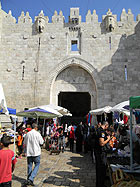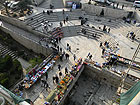| Conservation of the Damascus Gate Section |

|
The Damascus Gate section is located in the middle of the northern wall of the Old City. To the east is the moat section and to the west is the Franciscan section. There is extremely dense construction along the inside of the city wall and on the outside is the Walls Around Jerusalem National Park. Damascus Gate, which is the principal gate in the city's northern wall, serves as the main entrance for pedestrians to the Moslem and Christian Quarters (Figure 1). The level of Damascus Gate is lower than that of the street and the difference in elevation is bridged by means of a stepped gate plaza (Figure 2).
Physical Data
The overall length of the section is approximately 500 m and the elevation of the wall ranges between 760 and 780 meters above sea level. The total area of the exterior fa?ade is 6,200 square meters: the gate structure is c. 1,200 square meters, east of the gate is c. 750 square meters and west of it is c. 4,200 square meters.
Values for Conservation
Environmental-Urban Values.
Along the outer facades of the section is a public park, while the inner facades are concealed by buildings adjacent to the city wall. The height of the buildings in this section of the wall exceeds that of the crenellation and delineates the city's skyline.
An important point along the city wall is Zedekiah's Cave, the entrance to which is located east of Damascus Gate. The cave extends approximately 300 meters beneath the Moslem Quarter and has tourism potential as an additional attraction to touring the city wall promenade.
Note: The values of Damascus Gate are listed below in the section on "Conservation of Damascus Gate".
Physical Problems
The Damascus Gate section of the city wall is stable and in a good state of preservation; however, the ravages of time that have taken their toll on it are clearly apparent. The most common problems are: the top of the city wall is not sealed, mortar is missing, the stones in the crenellation are in danger of becoming detached, cracking, vegetation is taking root and damage is caused by iron elements that also accelerate the weathering and destructive process.
The Conservation Measures
1. Removing iron elements.
2. Stabilizing the stonework.
3. Rebuilding a section of the damaged crenellation.
4. Vegetation control; manually removing the vegetation and spraying an herbicide to prevent it from taking root again.
5. Stabilizing the crenellation stones with mortar and anchoring the stones by means of inserting pins.
6. Grouting (injecting mortar into the core of the wall).
7. Pointing up the stones joints with mortar.
> Conservation of the Gate
|
|

|
| 1. General view of the gate structure, 2011. photograph: Avi Mashiah |

|
| 2. The stepped gate plaza, 2011. photograph: Avi Mashiah. |
|















